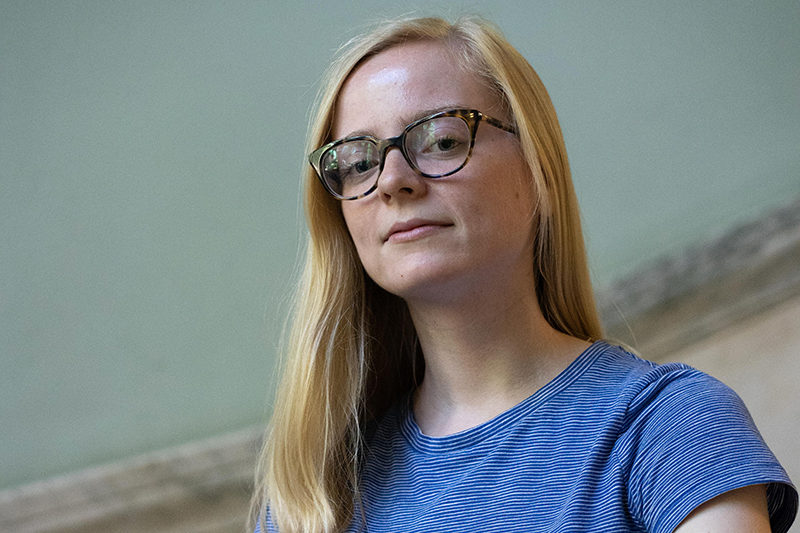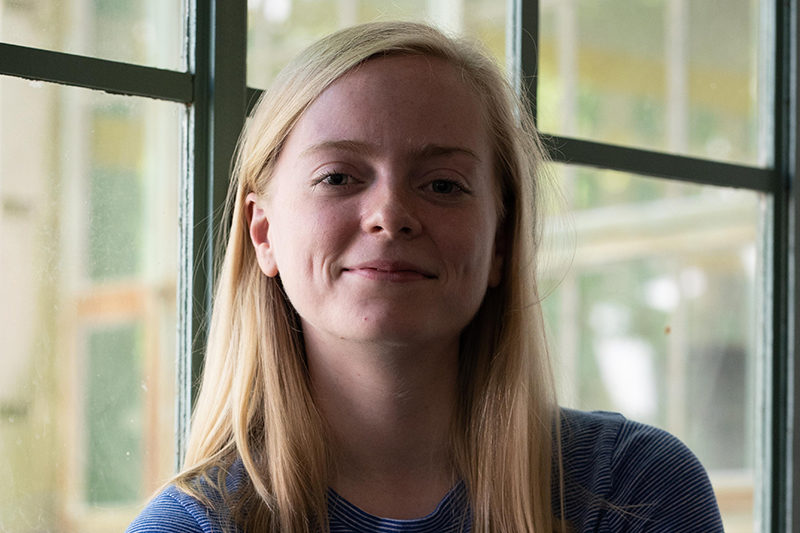An Undergrad Astronomy Major Helps Revolutionize Her Field
By Sahar Chmais
Reporting Texas

Anne Dattilo. Nadia Elchmaissani/Reporting Texas
Anne Dattilo made lemonade out of lemons and in so doing grabbed the world’s attention. For lemons, she had noisy data from the K2 spacecraft mission. To make lemonade, she built a neural network that finds exoplanets.
Dattilo, 22-year-old physics and astronomy undergraduate at the University of Texas at Austin, found two exoplanets, or planets outside Earth’s solar system — an accomplishment in itself. Experts agree that her bigger achievement in advancing astronomy, however, is to help reduce significantly the time astronomers spend looking through data. Her work may also encourage more women to enter STEM fields and show young astronomers a potential path they can focus on, said Joshua Winn, astrophysics professor at Princeton University.
“I’m glad young people find this field interesting,” Winn said. “This is time for rapid discoveries. And we need these young people who are ambitious and industrious.”
Dattilo said she “kind of fell into” a situation where she could do the work that led to the discovery.
The Kepler spacecraft launched in 2009 and monitored over 150,000 stars in one region of the sky in pursuit of exoplanets similar to Earth. In 2014, after the probe encountered mechanical difficulties, scientists reprogrammed its sensors and rechristened it as K2. The new configuration gathered 10 times more information in a shorter time span.
In 2016, Christopher Shallue, 29, a Google Brain software engineer, read that humans had trouble analyzing the huge volume of Kepler data and wanted to help solve the problem. He began searching for an astronomer and found Andrew Vanderburg, 27, a postdoctoral researcher at UT-Austin. Vanderburg suggested Shallue work on a neural network, a type of artificial intelligence that functions similarly to the human brain and recognizes patterns in data, for the Kepler mission.
On Nov. 13, 2017, Vanderburg delivered a guest lecture to Dattilo’s undergraduate research class and told the students he would like someone to work with him on adapting Shallue’s code to create another neural network that would find exoplanets in the K2 data. Dattilo raised her hand.
In December 2017, Dattilo got the green light to work on Shallue and Vanderburg’s vision.
Starting in spring 2018, Dattilo and Vanderburg would meet once a week to discuss the next step of her work. By the next week, she would have advanced steps beyond the original problem, Vanderburg said.
He half-jokingly told Dattilo toward the end of her research that he wanted planets on his desk by the end of the week. She came through. In August, Dattilo discovered two exoplanets using her MacBook and a hard drive of K2 data.
Dattilo mostly developed the code during her summer break, working from 8 a.m. to 5 p.m. five days a week. Sometimes she would watch videos about neural network development with her boyfriend and two brothers to share the learning experience.
During the fall semester, Dattilo arrived on campus early, when student sightings are scarce, to work in peace. She found time to fit writing her research paper around her other course work. Vanderburg commends her time management skills.
“She made a goal to build a neural network, find some planets, write a paper on it … and that’s not an easy goal to accomplish,” Vanderburg said. “It was a really impressive feat that she accomplished in a fairly short amount of time.”
Dattilo graduates from UT-Austin later this month and will continue her research into exoplanets by pursuing a doctorate in astronomy at the University of California Santa Cruz.
Fusing the field of astronomy with coding ranks high on Dattilo’s subjects of interest, she told Reporting Texas. She tended to direct her answers away from her personal life and toward astronomy research.
When Dattilo speaks about her work on discovering planets and overcoming countless technical hurdles, her speech intensifies and her smile widens. “I think it’s important to understand where we are in the universe,” she said. “Who we are in the universe and why, and so you can answer the big questions with astronomy… or some of them at least.”

Anne Dattilo. Nadia Elchmaissani/Reporting Texas
In fact, she’s so set on answering questions she decided to share her work on GitHub, an open-source code development site. Her idea is that scientists need to rely on other scientists’ work to advance. If everyone had to work from scratch, advancement would be minimal. So the work is open to the public.
“What I love about this story is not only a student doing something creative and new,” Winn said, “but it also validates the effort to make the data public.”
Astronomy is at a point where there’s too much data and too few astronomers. Dattilo’s work helps advance science by making the data analysis better automated and more efficient, Vanderburg said. Finding the two exoplanets was a plus.
Dattilo had two main inspirations at Cedar Park High School, computer science teacher Cheri Whalen and physics teacher Marilyn Theisen.
“I had a lot of female science teachers but a lot of those teachers weren’t invested in science,” Dattilo said. “My high school physics teacher had worked in industry previously as a chemist, so she really loved it. And I decided if she really loves it, I can really love it too.”
Whalen’s class had a few female students, a situation that hasn’t changed much since she entered UT. Her astronomy and physics courses had a very low ratio of women to men.
“I have sat in a classroom before, looked around and realized I’m the only woman in the room besides the professor,” Dattilo said. “I spent a lot of time building up a very big support system of women at UT because it can be challenging. There are a lot of men and those men think they’re extremely intelligent and want you to know about it. So it’s kind of a battle in classes to be like, you know, I also deserve to be here, and I’m also intelligent.”
Still, Dattilo struggles with how to think about gender. She considers herself a female scientist, but she also wonders why her gender should matter. Nonetheless, being a female scientist has given Dattilo some feeling of empowerment. U.S. Rep. Will Hurd, R-San Antonio, tweeted about Dattilo using her as an exemplary figure for other girls interested in STEM fields.
For any girls who don’t think #STEM is for them, meet Anne Dattilo, @UTAustin senior who at just 22 years old is helping usher a new era in astronomical research through artificial intelligence. Incredible work, and keep paving the way for #WomeninSTEM! https://t.co/v1Y7V46IEI
— Rep. Will Hurd (@HurdOnTheHill) April 1, 2019
“It felt really good that I could be an inspiration to young girls out there because I don’t think I had a lot of true inspiration when I was young from female scientists,” Dattilo said. “Because who can you name, Marie Currie, maybe? There’s so few otherwise.”
Given all the attention her achievements have received from NPR, various other news sources and scientists in the field, Dattilo believes the media should focus on other research students’ work and less on hers. But she does admit her story has all the buzzword elements to capture an audience.
After all the stories published about Dattilo’s neural network, Facebook friend requests poured in. Dattilo said she would get about 25 friend requests from men on a daily basis.
“I just feel like, ‘You know what guys, I’m not that cool,’” Datillo said. She laughed.
“I’m just an astronomer. We’re all socially awkward.”